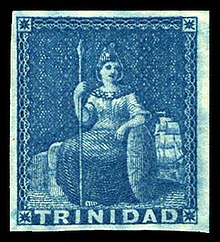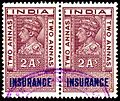Key type stamp




Key type stamps are stamps of a uniform design that were widely used by colonial territories in the 19th and 20th centuries.
Origins
[edit]The idea was invented by Perkins Bacon who used it to print stamps for Trinidad (1851), Barbados (1852) and Mauritius (1858), all featuring the same Britannia design.
Key plate stamps
[edit]The idea was refined by De La Rue in 1879 when the printing process was split into two through the use of a key plate (or head plate) for the bulk of the design and a separate duty plate for the name of the colony and the value.[1] These are often known as key plate stamps. While key type stamps are always of one colour, key plate stamps are bi-coloured. This method has the advantage that most of the design remains the same in each of a stamp series with only the value, name and colours changing.
Key plate stamps were used extensively by Great Britain, Germany, France, Spain and Portugal.[2]
Revenues
[edit]Key plates were also a ubiquitous feature of revenue stamps of Burma/Myanmar, Great Britain, India, Ireland, Malta and Pakistan. These had a tablet at the bottom, and this was appropriated (overprinted to indicate the type of use), e.g. Consular Service, Contract Note, Notarial, Special Adhesive, Stocks & Shares. Malta was the only country to also issue unappropriated stamps (with the bottom tablet still blank).
-
British 1891–1893 Queen Victoria revenue stamps appropriated for Transfer Duty
-
British 1903 King Edward VII revenue stamp appropriated for Petty Sessions for use in Ireland (further overprinted for Dog Licence)
-
Irish 1925 Harp revenue stamp appropriated for Passports
-
Indian 1937 King George VI revenue stamp appropriated for Insurance
-
Malta, 1954 Queen Elizabeth II revenue stamp with an unappropriated tablet at the bottom
See also
[edit]References
[edit]- ^ Mackay, James. Stamp Collecting: Philatelic Terms Illustrated. 4th edition. London: Stanley Gibbons, 2003, p.76. ISBN 0-85259-557-3
- ^ Sutton, R.J. & K.W. Anthony. The Stamp Collector's Encyclopaedia. 6th edition. London: Stanley Paul, 1966, p.165.
Further reading
[edit]- Fernbank, Peter E. King George V Key Plates of the Imperium Postage and Revenue Design. Banbury: West Africa Study Circle, 1997. ISBN 0952568721
- Lowe, Robson. The De La Rue Key Plates, London: 1979.
- Yendall, Eric. King George VI Large Key Type Revenue and Postage High Value Stamps 1937–1953. London: Royal Philatelic Society, 2008.





